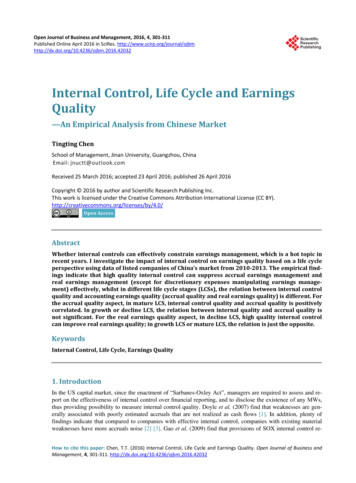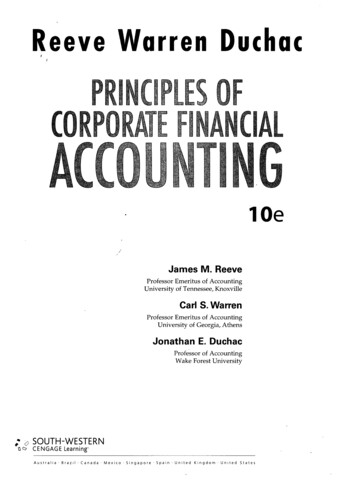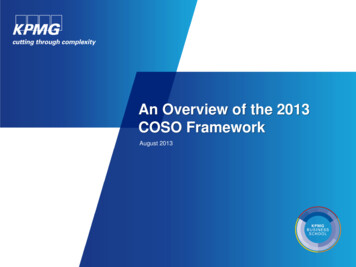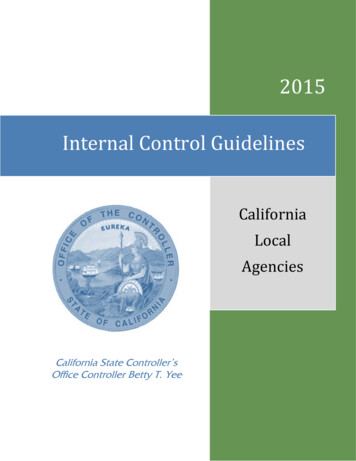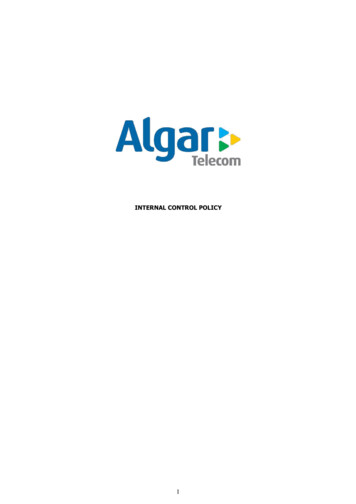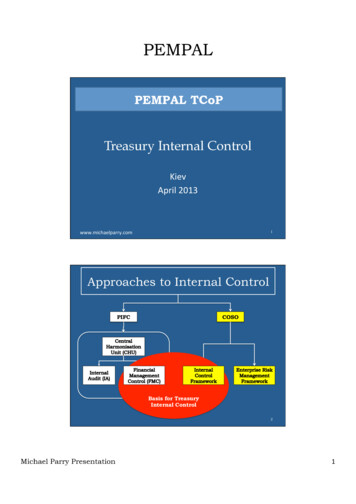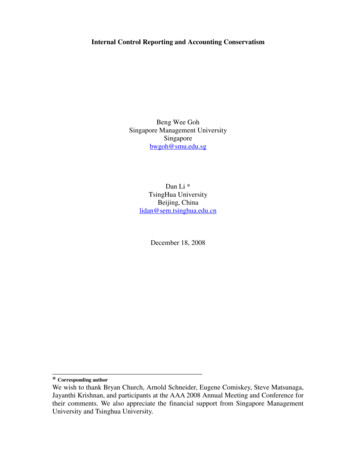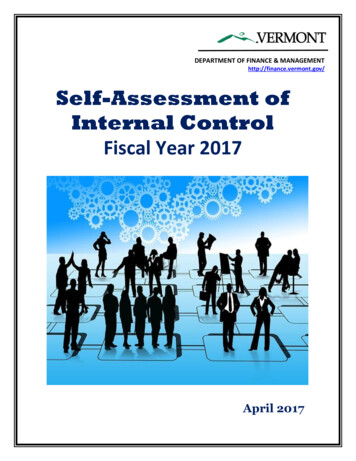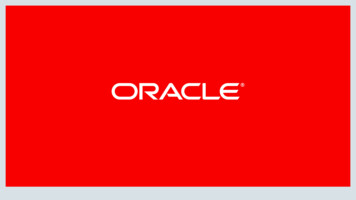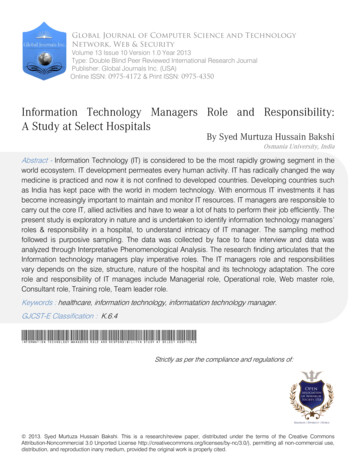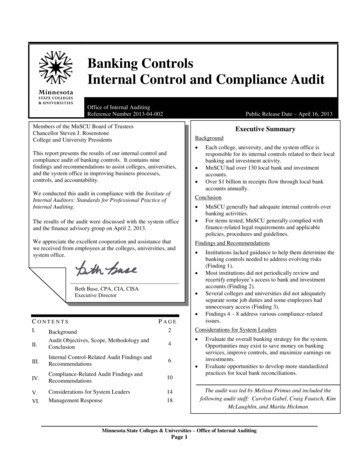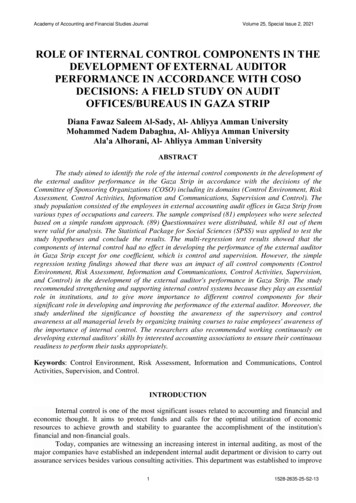
Transcription
Academy of Accounting and Financial Studies JournalVolume 25, Special Issue 2, 2021ROLE OF INTERNAL CONTROL COMPONENTS IN THEDEVELOPMENT OF EXTERNAL AUDITORPERFORMANCE IN ACCORDANCE WITH COSODECISIONS: A FIELD STUDY ON AUDITOFFICES/BUREAUS IN GAZA STRIPDiana Fawaz Saleem Al-Sady, Al- Ahliyya Amman UniversityMohammed Nadem Dabaghıa, Al- Ahliyya Amman UniversityAla'a Alhorani, Al- Ahliyya Amman UniversityABSTRACTThe study aimed to identify the role of the internal control components in the development ofthe external auditor performance in the Gaza Strip in accordance with the decisions of theCommittee of Sponsoring Organizations (COSO) including its domains (Control Environment, RiskAssessment, Control Activities, Information and Communications, Supervision and Control). Thestudy population consisted of the employees in external accounting audit offices in Gaza Strip fromvarious types of occupations and careers. The sample comprised (81) employees who were selectedbased on a simple random approach. (89) Questionnaires were distributed, while 81 out of themwere valid for analysis. The Statistical Package for Social Sciences (SPSS) was applied to test thestudy hypotheses and conclude the results. The multi-regression test results showed that thecomponents of internal control had no effect in developing the performance of the external auditorin Gaza Strip except for one coefficient, which is control and supervision. However, the simpleregression testing findings showed that there was an impact of all control components (ControlEnvironment, Risk Assessment, Information and Communications, Control Activities, Supervision,and Control) in the development of the external auditor's performance in Gaza Strip. The studyrecommended strengthening and supporting internal control systems because they play an essentialrole in institutions, and to give more importance to different control components for theirsignificant role in developing and improving the performance of the external auditor. Moreover, thestudy underlined the significance of boosting the awareness of the supervisory and controlawareness at all managerial levels by organizing training courses to raise employees' awareness ofthe importance of internal control. The researchers also recommended working continuously ondeveloping external auditors' skills by interested accounting associations to ensure their continuousreadiness to perform their tasks appropriately.Keywords: Control Environment, Risk Assessment, Information and Communications, ControlActivities, Supervision, and Control.INTRODUCTIONInternal control is one of the most significant issues related to accounting and financial andeconomic thought. It aims to protect funds and calls for the optimal utilization of economicresources to achieve growth and stability to guarantee the accomplishment of the institution'sfinancial and non-financial goals.Today, companies are witnessing an increasing interest in internal auditing, as most of themajor companies have established an independent internal audit department or division to carry outassurance services besides various consulting activities. This department was established to improve11528-2635-25-S2-13
Academy of Accounting and Financial Studies JournalVolume 25, Special Issue 2, 2021the institution's activities and add value to their performance. Besides, it helps the company achieveits goals by adopting a systematic and structured approach to improve risk management, control,and governance (Hayat, 2015).Furthermore, the external auditor's internal control is also considered one of the mostimportant domains through which the audit, evaluation, and reliability activities are the core subjectof interest (Al-Husseini & Al-Sa'abary, 2017). Various laws and organizational systems have beenintroduced to support this argument to achieve progress in work and control activities appropriately.Therefore, the internal control systems emerged as a reference for stakeholders in these systems,including the Committee of Sponsoring Organizations (COSO), which established the basiccomponents or components of internal control/ monitoring systems (Al-Bawab, 2015). Thesesystems focused on finding out the coefficients that could be behind fraudulent or false financialreports relating to corporations' business and the stakeholders submitted their recommendations topublic institutions, independent auditors, education institutions, Securities and Futures Commission(SFC) and other organizational agencies or commissions (COSO, 1985).As a result, some audit firms and bureaus became interested in focusing on internal controlsystems to protect funds, issue reliable financial reports to help external auditors perform their tasksand mission appropriately and inform the board of directors with their reports efficiently andeffectively. (Abu Mayaleh, 2017). So, this study sheds light on the role of internal controlcomponents and stresses the need to follow COSO's resolutions in seeking to develop and upgradethe performance of external auditors. The study addresses a case study of certified accountants inGaza Strip.Problem of the StudyPalestinian accountants depend on international auditing and accounting standards informulating their financial statements, and they face many professional developments andexperiences around the world. Therefore, external auditors must prove this in their reports inaccordance with international auditing standards. However, the audit profession in Gaza Strip hasbeen negatively affected by the political situation and the siege, which has affected the economicsituation. Accordingly, this status influences audit bureaus' performance, which is reflected in theauditors' professional performance quality. Nonetheless, there are some obstacles related to pooraccounting awareness and the lack of commitment to the internal control system. The performanceof the external auditors will improve if they abide by these regulations and systems.Hence, the study's problem lies in identifying the role of internal control in accordance withthe decisions of the COSO in developing the performance of the external auditor in the audit officesin Gaza Strip. Thus, the problem of the study focuses on answering the following question: To whatextent the degree of commitment of audit offices in Gaza Strip to the structures of internal controlsystems is in accordance with the COSO model in all domains (Control Environment, RiskAssessment, Control Activities, Information and Communications, Monitoring and Follow-up)?This question is divided into the following sub-questions:1.2.3.4.5.What is the role of the internal control environment in the development of external auditor performance?What is the role of risk assessment in the development of external auditor performance?What is the role of control activities in the development of external auditor performance?What is the role of information and communications in the development of external auditor performance?What is the role of control and supervision in the development of external auditor performance?Significance of the StudyThe study's significance is represented in the importance of any company's internal controlsystem, as it is considered the mainline of defense that protects the interests of the shareholders andall stakeholders. Moreover, the internal control of the company prevents issuing fraudulent or fakefinancial reports. However, we have to bear in mind that these components have a major role in21528-2635-25-S2-13
Academy of Accounting and Financial Studies JournalVolume 25, Special Issue 2, 2021improving the quality of the external auditor's performance. This study is one of the rare andimportant studies that aim to shed light on the audit offices' performance in Gaza Strip.Objectives of the StudyThe main objective of the study is to identify the role of the internal control componentsaccording to the decisions of COSO including its domains: (Control Environment, RiskAssessment, Control Activities, Information and Communications, Monitoring and Follow-up) indeveloping the performance of the external auditor in Gaza Strip. To achieve this objective, thestudy seeks to accomplish the following sub-objectives: Recognize the role of the internal control environment in developing the performance of the external auditor.Detect the role of internal control risks in developing the performance of the external auditor.Identify the role of the nature of internal control activities and procedures in developing the externalauditor's performance.Determine the role of information and Communications in developing the performance of the externalauditor.FIGURE 1THE MODEL OF THE STUDY WAS DESIGNED BY THE RESEARCHERS, INACCORDANCE WITH THESE REFERENCES: NASR AND SHEHATAH (2016), ALTHAHABI (2007), AND COSO (2013).The Variables of the Study are Identified as follows:Independent VariablesThey consist of internal control components in line with COSO 2013 framework: (ControlEnvironment, Risk Assessment, Information and Communications, Control Activities, Supervision,and Control).External Auditor performanceExternal auditor performance incorporates: (professional competence and educationqualifications, auditor's experience, objectivity and independence, related to the audit bureau, andcoefficients associated with the audit team).31528-2635-25-S2-13
Academy of Accounting and Financial Studies JournalVolume 25, Special Issue 2, 2021Study HypothesesThe main hypothesis HO: There is no statistically significant impact at the level of significance (α .0( forthe combined internal control components (Internal Control Environment, Risk Assessment, Control Processes,Information and Communications, Control and Supervision) on developing the performance of the external auditor inGaza Strip.The first sub-hypothesis (H01): There is no statistically significant impact at the level of significance (α 0.0)of the internal control component (Internal Control Environment) on developing the performance of the externalauditor in Gaza Strip.The second sub-hypothesis (H02): There is no statistically significant impact at the significance level (α 0.05)of the internal control component (Risk Assessment) on developing the performance of the external auditor in GazaStrip.The third sub-hypothesis (H03): There is no statistically significant impact at the significance level (α 0.05(ofthe internal control component (Control Activities) on developing the performance of the external auditor in Gaza Strip.The fourth sub-hypothesis (H04): There is no statistically significant impact at the level of significance (α 0.05) of the internal control component (Information and Communications) on developing the performance of theexternal auditor in Gaza Strip.The fifth sub-hypothesis (H05): There is no statistically significant effect at the level of significance (α 0.05)of the internal control component (Control and Supervision) on developing the performance of the external auditor inGaza Strip.THEORETICAL FRAMEWORKRole of Internal Control Components According to COSO decisionsDevelopment of the concept of Internal ControlAfter the emergence of the global economic crisis, the issue of internal control wasintroduced first in 1929 in the United States of America because of the willingness of Americaninstitutions to reduce the costs of external auditing, which was applied for the endorsement ofbudget accounts and financial statements (Renad, 2010).Moreover, there is a need for introducing control systems to improve workflow and boostcommitment to the policies and instructions of senior management authorities and run the large sizeof projects and face new challenges represented in the emergence of voluminous multi-national andinternational companies with multiple owners, as well as the complexity of their activities andactivities.In 1992, the American Institute of Certified Public Accountants (AICPA) and the TreadwayCommission established a committee concerned with internal control known as the Committee ofSponsoring Organizations (COSO), which has adopted an integrated framework for internal control.In 2013, the committee identified the basic internal control components: (Control Environment,Control Activities, Risk Assessment, Information and Communications, Supervision, and Followup) (COSO, 2013).Sharma & Senan (2019) said that "Internal control depends and interrelated to fivecomponents viz control environment, risk assessment, management information system andcommunication system, control activities and self-monitoring."Characteristics/Features of Internal controlThe internal control system is characterized by a set of features and advantages throughwhich it is possible to estimate its capacity, efficiency, effectiveness, and the degree of itsimplementation in the company. These characteristics and features include the following (Majlakh& Waleed, 2018):41528-2635-25-S2-13
Academy of Accounting and Financial Studies JournalVolume 25, Special Issue 2, 2021 Relevance: The institution must use a new supervisory system that suits its business'snature and size, mainly for the small enterprise. Its management should choose a simplecontrol system that is not complicated and vice-a-versa for large enterprises. Comparing Revenue against Costs: Any business of the company or enterprise dependson comparing returns with costs. The greater difference between them is greater profitpercentage will be accomplished. Flexibility: The method of the applied control style must be flexible to meet the company'sneeds; so that these methods can be modified and developed in order to adapt to anyexpected changes. Effectiveness: It is a sound and well-developed control system capable of finding outerrors and detecting any nonconformity before they occur and handling them in a logicalway that ensures that they will not happen again in the future.Objectivity: The control system is designed to help attain correct, thorough, and accurateinformation about the company's performance in the appropriate time and validating their sourcesthrough records and documents on the one hand. On the other hand, stakeholders in charge of thevarious control activities have to consider the time issue into account, most specifically those whomake financial reports or statements, by delivering them at the fixed time.Objectives of Internal ControlEvery system has a goal or a set of objectives to be achieved. Internal control purposes canbe derived from the definitions mentioned earlier, especially the definitions identified by AICPA(Turner & Weickgenannt, 2009). The main objectives of internal control include the followingcomponents:1.2.3.4.5.Protect the company assets from fraud and manipulation: for example, allocating a digital safe to insure thecompany against risks, theft and fraud, and assign closed places for stores and use modern means to openand close these stores (Al-Husseini & Al-Sabry, 2017).Verify the accuracy of data and the accounting reports and make sure to use them to design and developadministrative policies and decisions: This is based on the accuracy of registration and operating processesthat require specific effort and verifying each process in terms of documents or records. Thus, this processinvolves establishing an independent internal audit department, which plays a key role in this regard(Gourari, 2015).Upgrade the level of productive proficiency: through the effective exploitation of resources and avoidingpractices of overindulgence and wasting the utilization of available resources, i.e., adhering to the lowestcosts.Evaluate the levels of implementation in various departments of the company.Enhance commitment to internal policies and decisions.Internal Control must be Addressed through Three Domains to Achieve the FollowingObjectives:1.2.3.Administrative Control: This includes the organizational plan, procedures, documents, and records aimed atachieving the highest level of productive efficiency while encouraging commitment to administrative policiesand decisions. This control's objectives can be achieved by issuing statistical statements, reports onperformance and quality assurance, and submitting estimated budgets (Al- Saberi, 2016).Accounting Control: It represents the organizational plan and all procedures targeted at validating theaccuracy of the accounting data included in the account books, invoices, bills, and accounts (Al- Shuhnah,2015).Internal control: Involves all methods, means, and procedures targeted at protecting the project assets fromfraud and loss. In order to achieve its objectives, internal control depends on dividing work together with selfmonitoring. So, every employee's performance is subject to review by another employee who also participatesin implementing this process (Al-Saberi, 2016).51528-2635-25-S2-13
Academy of Accounting and Financial Studies JournalVolume 25, Special Issue 2, 2021Basic Components of Sound Internal Control SystemsSound internal control system consist of an administrative, organizational structure, an accountingsystem, detailed procedures for implementing tasks, selecting competent employees and placingthem in appropriate positions, an accurate performance monitoring system, and the utilization of allautomated methods.Background of the Formation of the COSOThe breakdown of large American companies in 1985 resulted in an obvious failure andsetback in auditing their accounts. Hence, the US Congress and the US Securities Commissionlaunched a campaign to reform the Foreign Corrupt Practices Act of 1987, which led to creating aNational Committee to handle the fraudulent financial reports (Treadway Commission). Thiscommittee consists of several associations and accounting institutes in the United States of America(Thabit et al., 2017), including:1.2.3.Financial Executives International (FEI).American Accounting Association (AAA)Institute of Internal Auditors (IIA)Treadway Commission conducted a study on financial statements in the time between 1985and 1987. It then issued a report, including the findings and recommendations under the title"Report of the National Committee on the preparation of fraudulent financial reports" (COSO,1987). After that preliminary report was submitted, COSO was formed and made its report on thereasons behind the risks related to internal control issues that also led to the failure to preparefinancial reports. COSO urged the management to submit reports on the effectiveness of internalcontrol systems and stressed the need to focus on some main issues, including the creation ofeffective internal control systems, a sound control environment, codes of conduct, specialized auditcommittees, effective management, and project risk management, (Länsiluoto et al., 2016).In September 1992, as one of the Treadway Committee committees, COSO submitted areport stressing developing a comprehensive definition of internal control. In addition toestablishing an internal control structure and its five components, setting standards that help internalauditors evaluate this structure's effectiveness and prepare reports on the results to providereasonable confirmation for building up confidence in financial statements (Al-Shahawi, 2012).The reports issued by COSO defined the internal control structure as; A process designed toget reasonable affirmation of achieving three main objectives: the efficiency and effectiveness ofactivities and operations, reliability of financial statements and confirmation of their conformity togenerally accepted accounting principles, and ensuring their compliance with the companys' lawsand regulations (Safi, 2019).COSO framework in 1992 is considered a turning point and a fundamental stage oftransformation in the development of the internal control structure, which was updated in 2013when the enterprise or the company risk management has become a highly essential requirement.This framework consists of five components representing the internal control structure (ControlEnvironment, Control Activities, Risk Assessment, Monitoring, Information, and Communications)(Safi, 2019).(Sarhan, 2017) argued that most of the 1992 framework fundamentals were maintained oreven slightly modified within the framework of 2013. There were no changes in the definition ofinternal control, and no change has been made on the number of components of the internal controlstructure. In addition, the internal control structure of the enterprise is still based on defining goalsand the need to restructure a sound system to accomplish those goals.61528-2635-25-S2-13
Academy of Accounting and Financial Studies JournalVolume 25, Special Issue 2, 2021Components of an Integrated Framework for Internal Control According to COSO ConceptIn 1992, a committee called the COSO was established to give more focus on internalcontrol. This committee has approved and adopted an integrated framework for internal control,which was accredited around the world. On May 14, 2013, the committee identified the basiccomponents of internal control, which are according to (Khalidi, 2015): (Control Environment, RiskAssessment, Control Activities, Information and Communications, Monitoring and Follow-up).(COSO,2007):1.2.3.4.5.Control Environment: It includes the functions of management and persons who are in charge of theinstitutional control, in addition to their attitudes, positions, and actions towards the company's internal controland its importance. The control environment also defines the general framework of the company and the othercontrol components, and the auditor has to perceive and understand the control environment because the resultof his/her evaluation is reflected on the design and effectiveness of applying the components of the internalcontrol (Al-Thunaibat, 2015).Risk Assessment: The risk assessment in the financial statement management's analysis of risks is representedin preparing the financial statements in accordance with approved and accredited accounting principles. It isnot restricted to the financial statements and the perils associated with them. Still, it also involves all activitiesthat are supposed to determine activities, market and credit risks, threats of technology, and disasters (Ezz ElDeen, 2015).Control Activities: They represent the rules and procedures set by the institution or the company to ensuretheir implementation and the management directives that includes the company's control activities, theworkflow, the process of comparing actual performance against budgets and performance expectations for theprevious periods (Al-Samarra'i, 2016).Information and Communications: An effective internal control system involves reliable informationstructures and entails all the economic unit activities and effective Communications channels to ensure that allemployees understand and fully abide by organizational policies and measures related to their work andresponsibilities within the system. Furthermore, effective Communications must be open in all directions,which applies to the institution through its components and structure. Also, workers communicate importantinformation to the highest levels and maintain an open Communications with external parties and stakeholders.Therefore, when any danger hiders achieve the enterprise's objective, all necessary measures and actions canbe taken appropriately (Lathan, 2016).Monitoring and Follow-up: This component refers to the management's continuous evaluation or assessmentover periods of internal control performance quality to achieve the desired and planned level of controlimplementation, which will also help determine the possibility of modifying it inline with any expectedchanges. The information related to any amendment can be obtained by examining the current internal controlmethods and the assessment of banking regulatory bodies, feedback from employees and customer complaints,most specifically, those regarding numbers or figures in the invoices, etc. (Helmy, 2015).Definition of the External AuditThe external audit ensures the efficiency of an unbiased assessment that determines if theeconomic and administrative situation of the company activities complies with the set goals. So, theconcerned authorities and stakeholders will be informed in time with the results of the review orassessment (Sha'ath, 2016).Previous StudiesStudy of (Nashwan, 2018), which aimed to identify the impact of the internal controlsystems on construction companies' operational performance in Gaza Strip according to the COSOfive components (Control Environment, Risk Assessment, Control Activities, Information andCommunications, and Monitoring and Follow-up). The study examined the extent of constructioncompanies' commitment in Gaza Strip to the internal control system structures according to COSOmodel. To achieve the objectives of the study, (49) items were distributed to the sample consistingof (460) persons, and (415) questionnaires were retrieved for analysis, i.e., a ratio of 90.2. %. Thedescriptive-analytical method was applied. The study concluded that there was a commitment fromthose companies towards internal control structures. There was a statistically significant positive71528-2635-25-S2-13
Academy of Accounting and Financial Studies JournalVolume 25, Special Issue 2, 2021impact on every control component on their operational performance. The recommendations urgeconstruction companies to strengthen efficient and internal operative control systems and conductmore studies on other sectors such as commerce, industry, and services.The study of (Alslihat et al., 2018) aimed to identify the effect of the internal controlsystem's components on reducing cloud computing risks in Jordanian public shareholdingcompanies per COSO framework: A case study of accountants in Jordan. A questionnaire wasdeveloped as a tool to collect data, and the sample comprised 190 accountants. The questionnaireswere distributed to all sample members, and the SPSS software was used to analyze the data of 154questionnaires (i.e. represent 81.1%). The study concluded that COSO framework provides internalcontrol activities that reduce the risk of adopting information systems in general and accountinginformation systems in particular. The Association of Accountants and Auditors and theSupervisory Authority recommended developing educational programs and strengthening trainingfor auditors on the usage of computers and motivating the audit bureaus to conduct local andinternational research related to these programs. It is worth noting that information and cloudcomputing techniques are among the most important COSO framework developments.The study aimed to examine internal control systems' role, including their five components(Control Environment, Risk Assessment, Control Activities, Information and Communications,Monitoring, and Follow-up) play in reducing risks from a future stock prices' crash distinguisheddata from China conducted by (Chen Jun, 2017). This study reached that internal control systemsare negatively related to the risk of stock prices' crash, most specifically the control environment,information, and Communications that are negatively related to the risk of a breakdown in stockprices in the future. The recommendations call for continuous improvement of the structure ofinternal control systems and adherence to companies' governance principles.(Lagat et al., 2016) tried to determine the impact of internal control systems on financialmanagement in Baringo County government in Kenya, depending on the (COSO) framework toanalyze the internal control systems. The study concluded that the monitoring activities and followup of the information and communications technology greatly affect financial management.However, the control environment, information, and communications do not significantly affectchanges in financial management. The study recommended strengthening internal control systemsto enhance accountability and improve financial management.METHODOLOGY OF THE STUDYThis study is a descriptive-analytical study that aims to answer an important question relatedto the role of internal control components in developing the external auditor's performance inaccordance with the decisions of the COSO. It is a field study on audit bureaus in Gaza Strip basedon two data types, including the secondary data and the primary data. It can also be classified as adescriptive study aimed at determining the coefficients addressed by previous studies reviewed inthe theoretical framework.Population and Sample of the StudyThe study population includes employees in external accounting audit bureaus in Gaza Strip,regardless of their different positions and job titles. The study sample consisted of (81) workers inthese bureaus selected by a simple random sample method, and (89) questionnaires weredistributed. In contrast (81), questionnaires were retrieved and were valid for analysis. Thefollowing table shows the demographic characteristics of the study sample.81528-2635-25-S2-13
Academy of Accounting and Financial Studies JournalVolume 25, Special Issue 2, 2021Table 1DISTRIBUTION OF THE STUDY male2530.9Below 25 years89.8From 25 to less than 354049.4From 35 to less than 452227.345 and more than 451113.5Senior auditor2733.3Assistant auditor4454.3Audit Manager45.0Owner or partner of an audit 390.2Business Administration56.2Economics11.2Financial and Banking Sciences22.4Less than 5 years1417.0From 5 to less than 103138.0From 10 to less than 151519.015 and more than 152126.0Palestinian University6074.0Arab University2025.0Foreign University11.081100%GenderAge lace ofstudyTotalData Collection ToolsThe study's essential tool was a questionnaire prepared to collect preliminary data anddeveloped for this purpose by referrin
Sponsoring Organizations (COSO), which has adopted an integrated framework for internal control. In 2013, the committee identified the basic internal control components: (Control Environment, Control Activities, Risk Assessment, Information and Communications, Supervision, and Follow-up) (COSO, 2013).
